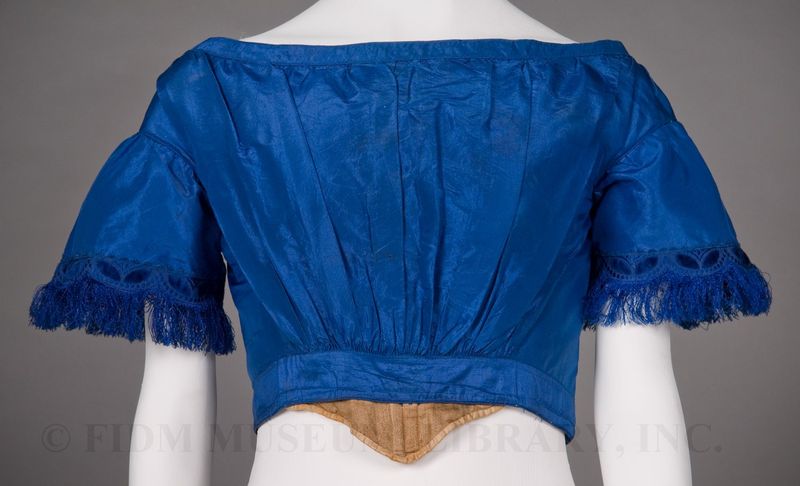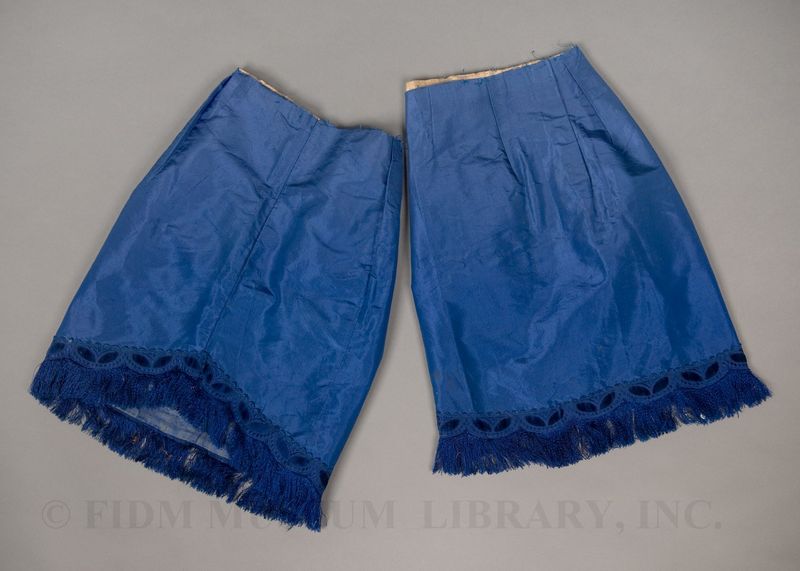This bright blue bodice is a bit of a puzzle. Look closely at the image, and you'll probably notice something strange happening at the waist. Do you see the coarse cotton lining peeking out from below the blue silk waistband? The V-shape of the lining indicates the original waistline of the bodice, which was later altered to reflect changing fashions. This alteration probably took place about 1860-62, when a lowered V-waist went out of fashion. Keep reading to learn about another significant alteration to this bodice!
 Bodice
Bodice
Silk with cotton lining
c. 1850-62
Gift of the Helen Larson Estate
S2001.31.1A
We have a number of pieces in our Study Collection that show both major and minor alterations. In an era when on-trend clothing can be purchased so inexpensively, it's hard to imagine someone making the time to alter a garment to better fit a changing body or changing fashions. The refashioned garments in our collection point to a time when clothing was an expensive commodity, and it was therefore worth taking the time and effort to update or alter a garment. Our post on refashiong garments features an 1850s dress with day and evening bodices, and a Balenciaga suit with multiple dickies.
In its current incarnation, our blue silk bodice was probably intended for evening wear. The low neckline and short sleeves are the key, as exposed shoulders and arms were appropriate only for evening wear during this period. Before it was altered, the bodice was probably part of a day ensemble. We have surmised this because the donation also included the lower sleeve portions, seen below. It's amazing that bodice and sleeves remained together until arriving at the FIDM Museum!
When still attached to the bodice, the sleeves would have created a two-tier pagoda effect, similar to the sleeves seen in this c. 1850 daguerrotype of an unidentified African American woman. This photo has particular relevance to our bodice, as the bodice pictured has also been refashioned. Notice the off-center ruching and darts, which indicate that the bodice was cut down to fit the current wearer. Joan Severa discusses this daguerreotype in her book Dressed for the Photographer. This is a fantastic book for 19th century research–try to add it to your library if you don't have it already!
 Sleeves
Sleeves
c. 1850-62
Gift of the Helen Larson Estate
S2001.31.1BC
The neckline is still puzzling. If originally created as a woman's day bodice, the shoulder baring neckline seems too revealing, though it makes sense as an evening neckline. It's possible that the neckline may have been altered to its current state, with extra fabric from the waist alteration or a matching skirt used to band the neckline. Another possibility is that the bodice neckline is unaltered, but was worn over a chemisette. A chemisette was a lightweight dickie made of varying fabrics, worn to cover the bare skin exposed by a low neckline. Peterson's Magazine discussed the chemisette in June 1849, with the observation that necklines were being cut lower, and corsages (bodices) were often worn over a chemisette. In the typically directive editorial style of fashion periodicals past and present, Peterson's recommended that when worn, a chemisette "should be trimmed at the top by a band of worked insertion, (under which a ribbon can be passed at pleasure) surmounted by a narrow lace."


Very interesting post again. I’m designing costumes for operas at the moment – the high quality pictures here are a great help. And the text are just a very insightful read. Thanks for putting those up.
Thank you so much for your kind words about our blog. It’s great to hear that the pics are helpful to your design research…that’s one of the reasons we started this blog!
Looking at the bateau neck it is very possible as well that this dress was made for a young lady as a day dress. It was very common to see girls between the ages of 14 and 17 wearing bodices of that style over corsets, hoops, and long skirts. Which would also lend itself to the pagodas being separate from the jockeys… They could have been detachable for different seasons…